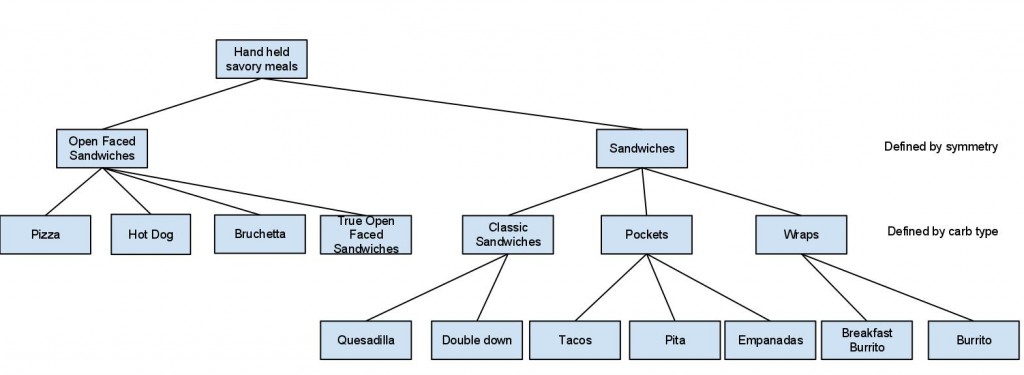It all started with two simple questions — Is a burrito a wrap? Is a wrap a sandwich? Over the past few weeks, I’ve been asking as many people as I can these seemingly simple questions.
I posed two questions on Quora:
Is a wrap a sandwich?
Is a burrito a sandwich?
Between Quora and the multitude of conversations I’ve had, it seems that everyone has a different answer, and there are very strong opinions.
The initial questions spidered into a variety of other questions:
- How do you define a sandwich?
- Is a quesadilla a sandwich?
- How do you classify a double down?
- What of open faced sandwiches?
In short, the relationship between the words we use to describe hand-held savory meals is non-existent. There is no taxonomy that illustrates how these different foods relate! With the help of a bunch of people, two models of classification have emerged.
Model #1: Hinges on symmetry as a defining characteristic
Click here to view the live Google Doc.
It splits the concept of hand-held savory meals into two categories — “open faced sandwiches” and sandwiches. Sandwiches are more or less horizontally symmetric. If you draw a horizontal line across the food item in question, the top will be symmetrical with the bottom.
The broad category of “open faced sandwiches” (and I agree, it could certainly use a different name) contains items such as pizza, hot dogs, true open faced sandwiches (items that if you placed an additional piece of bread on them they would become a true sandwich), bruschetta etc.
The sandwich family contains sub-families defined by the type of carbohydrate. There are classic sandwiches (two or more carbohydrate masses with fillings in between layer(s)) which contain club sandwiches, pockets which contain pitas, tacos, empanadas etc and wraps which contain burritos.
The interesting thing to arise out of this model is the notion that we use the word sandwich in 2 different ways (as a general category and as a discrete food item)– perhaps this is the reason why this debate began. Model #1 clearly answers the questions: is a wrap a sandwich (yes), is a burrito a wrap (yes), is a burrito a sandwich (yes — caveated with it being the category definition of the word sandwich).
Model #2: hinges on how many sides the item is covered with the carbohydrate

Click here to view the live Google Doc.
This model has 6 categories, names taken from Greek meaning covered on X side(s)
- Monokalupto (covered on one side). This neatly translates into model #1s “open faced sandwich” category. Here we ave pizza, bruschetta, etc.
- Bikalupto. This contains “true sandwiches”, quesadillas etc.
- Trikalupto. These are U/V shaped foods: hotdogs, hard tacos, lobster rolls etc.
- Tetrakalupto. These are rolled foods, open on both ends: soft tacos, spring rolls
- Pentakalupto. Pita based foods.
- Hexakalupto. Fully enclosed wraps, empanadas, burritos
The downside to model #2, which I think is overall neater and easier to organize than model #1, is that it doesn’t answer the questions that we set out to ask: Is a burrito a wrap? Is a wrap a sandwich?
Conclusion
These are taxonomies in progress, evolving as more exceptions to the rules are found. I don’t think we’ve definitely answered the initial questions: Is a burrito a wrap? Is a wrap a sandwich? and I would like to have a model that most people agree with that definitely answers the questions.
Where from here? I’d love to hear your thoughts — are there any exceptions that don’t fit into these models? Are there places that the models break down? Something we’ve overlooked? Can you think of a better model? Have you seen someone else approach this question? Let me know — email me and if you’re feeling bold, feel free to make a copy of the Google Doc, rearrange the model and send back! Lets keep the discussion going!
